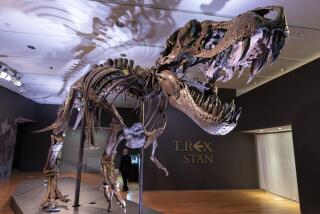Amazing lizard breath: Dinosaurs probably breathed better than you do
- Share via
Little-known fact: When it comes to extracting oxygen from the air we breathe, we humans are just OK.
Birds are more efficient breathers than us. So are alligators and, according to a new study, monitor lizards, and probably most dinosaurs were as well.
Humans are what are called tidal breathers. When we breathe in, fresh air moves into our lungs along progressively smaller airways, eventually ending in little sacs called alveoli, where our bloodstream picks up oxygen and deposits carbon dioxide. Then the “old” air moves out of our lungs along the same path it came in.
But birds, alligators and monitor lizards are “unidirectional” breathers. After the air moves into their lungs, it begins to follow a system of tubes similar to arteries, capillaries and veins. In this system, the air moves through the air tubes in only one direction.
[Updated, 12:10 p.m. PST Dec. 12]: Unidirectional breathing is complex. For more information on how it works, check out this reference page, sent in by a reader. Animations, videos, and graphics all illustrate unidirectional breathing.]
And, it turns out, their system is more efficient at extracting oxygen from the air than ours is.
Scientists discovered that birds are unidirectional breathers in the first half of the 20th century, after researchers noticed that pigeons breathing the sooty air of train stations showed just one black area on the lung. If the pigeons breathed like we do, scientists would have expected the entire lung to be black.
“The fact that only one part of the bird lung was dark suggested the air was flowing in one direction and that the first part of the lung to receive the contaminated air was filtering the particles,” said Colleen Farmer, an associate professor of biology at the University of Utah.
It isn’t that surprising that birds have developed a more efficient breathing system. Scientists hypothesize it may have evolved to help them support their high metabolic rates, or to help them survive when they fly at high altitudes, where oxygen is scarce.
But in 2010, Farmer published a study showing that alligators are unidirectional breathers as well.
“That’s when I realized it had to have a function other than supporting the high metabolic rates associated with birds,” she said. “I knew cold-blooded animals spend about 80% of their lives holding their breaths -- and so I formulated the hypothesis that this breathing would be important for mixing gases in the lungs during a breath-hold.”
On Wednesday, Farmer published a study in the journal Nature that shows monitor lizards are unidirectional breathers as well. She believes that further studies will show that all lizards and snakes are also unidirectional breathers.
“[Unidirectional breathing] appears to be much more common and ancient than anyone thought,” she said in a statement.
The scientists are still not sure exactly when unidirectional breathing first developed, but if it all evolved from one ancestor rather than concurrently, it is possible there have been unidirectional breathers walking the planet for 270 million years -- 100 million years before the first birds and 20 million years earlier than anyone thought.
And although it is impossible to directly study whether extinct animals like dinosaurs were unidirectional breathers, Farmer said that since alligators, birds and probably most lizards breathe this way, it’s likely the system was inherited from an ancestor the dinosaurs shared as well.
Farmer said the next step in her research is to determine just how common unidirectional breathing is or was.
“We want to look at a bunch of lizards and snakes and turtles and amphibians,” she said. “We have a lot of work ahead of us.”
You just read a story about hyper-efficient dinosaur breathing! Follow me on Twitter for more like this.
ALSO:
Scary smart! Clever crocodiles, alligators use sticks to lure prey
Video: A leaping, legless fish? This blenny is a snapshot of evolution
Does water still flow across Mars? Dark, mysterious tracks hold clues





